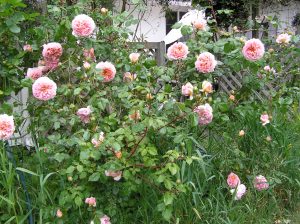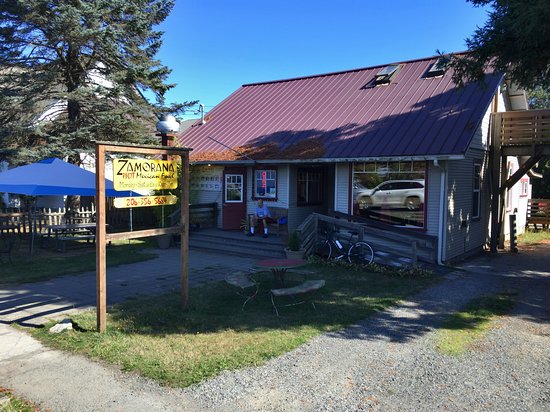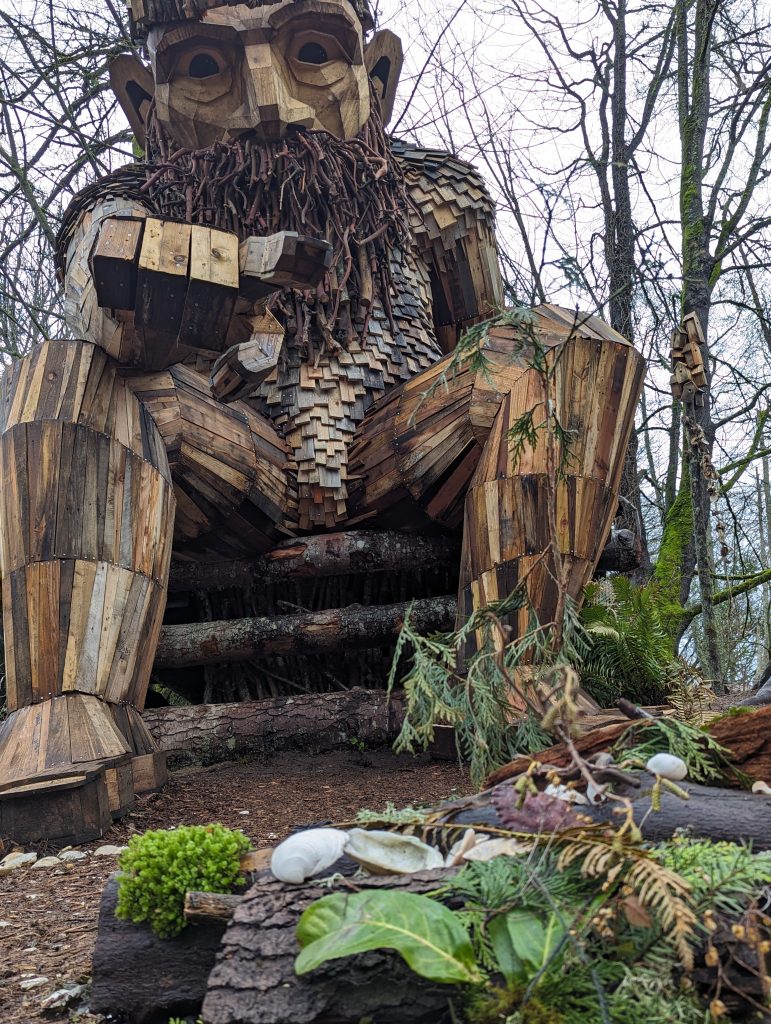In March, it is time to think about roses. First, we want to prune them in March. Why March? By March, the worst of our cold weather that can kill rose bushes is over. We’ll need to clean out any stems that died over the winter. We can be assured we won’t be pruning out the only stem that would survive a deep freeze. The plants are about to leaf out and put on a growth spurt. We’ll want all this energy to go into the parts of the plant we want to keep. The buds where new side stems will sprout are starting to swell and are easily visible.
There are several schools of thought on pruning. The scientists like to plant a whole row of roses, prune some, and let others grow naturally. Then, they count the size and number of blooms. They will proudly tell us that we will get more blooms by pruning. Pruning stimulates branching and eliminates thin, spindly stems that won’t bear full-sized blooms. The problem with heavy pruning is that the blooms will be a week or two later than if you don’t prune.
Now, since I’m always eager to have roses as early as possible, I’m tempted not to prune. I do get nice early roses. However, the stems on some varieties will be short. To get rid of dead wood and encourage longer stems, I cut the roses way back as I harvest. This enables longer stems and revitalizes the bush while still giving me some early flowers. I probably don’t get as many total blooms per bush.
Some people don’t prune their roses. They just let them grow and do their thing. They don’t count the number of blooms or worry about their size. When the bush blooms, they enjoy it. If it isn’t blooming, they don’t look at it.
Then, there is the Hubby-forgot-to-shut-the-deer-gate method of pruning. I read in a permaculture book that people do this. Basically, this method of rose pruning relies on the voracious neighbors. Deer are fenced away from the roses all season. When the roses are ready to go dormant in the fall, the gate is left open, and the deer are allowed to forage in the rose garden. I’m skeptical about this idea. It has been tried numerous times in my garden without my permission, and the results have never been good. The deer don’t prune to an outside-facing bud. They don’t clean out the dead wood. Some stems may get pruned down to the dirt while others are left waving seven feet in the air. I’ve had several deer-pruned roses die. After the deer have been in the roses, I usually go through and prune the stem back to an outward facing bud and cut off the broken and mangled stems while weeping and cursing the open gate.

Rose experts can tell you in great detail exactly how a rose must be pruned. Your knife or pruners must be super sharp and disinfected between each rose bush so you don’t spread disease. After you clear out all the dead wood, you cut the major canes back to an outward facing bud. Some people are even fastidious about how many outfacing buds must be left on a stem. Remove any spindly stems that won’t support the weight of a rose.
When I find myself worrying about my pruning technique, I remember a story I heard in a horticulture class. Grandma had a hedge of roses that were the pride of the neighborhood. Everybody loved those magnificent roses. When it was time to prune the rose hedge, Grandma needed her hip replaced. Someone volunteered the teenage grandson to prune the rose hedge for her. The kid fired up the chainsaw and mowed the whole hedge down to two feet high by two feet wide. Despite the total horror of this approach, the hedge grew just as lush and beautiful as ever. Not really believing this story, the scientists did a trial on their field of roses. Believe it or not, the roses pruned with a chainsaw grew back just fine and produced as many roses as those meticulously pruned by hand with a very sharp, sanitized pruner. The experts still shudder at the thought of pruning with a chainsaw and don’t recommend it.
In the real world, where most of us live, how you prune your roses will depend on how much time you have and how many rosebushes you have. Every year, I can prune maybe two dozen rose bushes. Hubby helps by pruning two. The rest of my roses get cut way back as I harvest the flowers. This works for me and for my roses. They seem healthy and happy.
After pruning, the next biggest question people ask about roses is, what about black spot? The best answer I’ve ever heard for how to deal with black spot came from the curator of a garden in England. This respected horticulturist said, “Don’t look at it.” She went on to extol the benefits of selective vision. Basically, black spot is ugly and causes the leaves to fall off your rose bush. It doesn’t harm an otherwise healthy rose bush planted in healthy soil. Some people who have more time, money, and energy than the rest of us will dust or spray their roses with something nasty containing sulfur. The leaves might look prettier than mine, and the gardener may feel in control of their world. I have no need for control and would rather focus my efforts on keeping my soil healthy.
Aside from not looking at the blackspot on my Abraham Darby rose, I’m careful to select rose varieties that are disease resistant. I make sure they have good air circulation around them. I usually feed them according to the results of my soil test. If I don’t have a current soil test, I give them a mix of four parts alfalfa meal, two parts bone meal, and one part greensand. Instead of buying expensive alfalfa meal, I buy organic alfalfa pellets for horses. As soon as I water the rose, the pellets dissolve into meal. It seems that every time I see a particularly lovely rose bush on this island the grower tells me the secret is in feeding them alfalfa pellets.
After your roses are pruned or not as you have time for, and you’re turning a blind eye to the blackspot, what else needs to be done for the roses? I recommend hanging bird feeders. I was watching my bird feeder one day when it was full of birds. I noticed birds landing in the nearby roses. While waiting their turn at the feeder, the birds inspected the roses for appetizers. They pretty much clean up any aphids that dare to land on the roses. Also, walking in the rose garden and smelling each bloom should be part of your daily routine while the roses bloom. If you find any bugs, you can squish them with your fingers and wipe their guts on your jeans.
The most important part of caring for your roses is really caring for your soil. Healthy soil is key to lush roses that don’t care how you prune, resist disease, and aren’t bothered by bugs. Good garden soil should be full of earthworms and fungi to feed your mycorrhiza.
Mulch helps maintain an even temperature around the rose’s roots and offers a habitat for beneficial fungi. It also feeds the soil with nutrients and humus. I mulch with composted duck yard litter. My added alfalfa meal blends well with my compost. My soil is light and crumbly. I allow the surface of the soil to dry out before watering.
The biggest complaint about roses is that they’re hard to care for. I don’t have the energy to fuss with a finicky plant, yet I grow enough roses to supply my flower stand while still having flowers to bring inside and enjoy in the garden. I suspect that when we start fussing over our roses, we create a problem. Give them healthy soil and some sunlight, and water them during the dry season, and they’ll thrive.






Thanks for your helpful article about roses. I enjoyed your stories about letting deer so the pruning (bad idea, in my opinion) and using a chainsaw. Good examples of the sturdiness of roses.